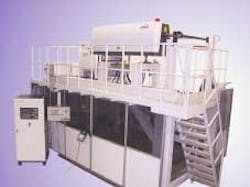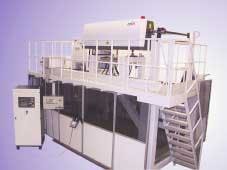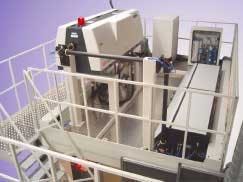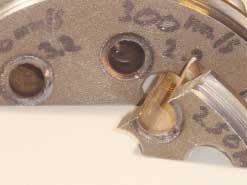The reality of remote laser welding
Ever since the advent of beam-steered pulsed Nd:YAG laser welding solutions in the 1980s, the laser industry has pushed to expand the scope and capability of this welding technique, which became known as remote welding. Beyond the impressive spectacle of metallic parts being joined at high speeds with this process, the benefits of remote welding were recognized at an early stage. Chief among these are: flexibility, speed to produce a seam weld (or series of stitches) with highly consistent quality, a high degree of automation possibilities, access to weld joints from one side, savings in material cost by elimination of flanges or tabs, reduced distortion from smaller total heat input, and lower maintenance costs compared to conventional resistance spot welding. The result of these benefits is lower direct cost per weld compared to those of resistance spot welding.
Rofin-Sinar Inc. (Plymouth, MI) was early in recognizing the advantages that remote welding could offer its customers, especially those in the automotive industry. The company's process, called Remote Laser Welding (RLW), uses the beam from a high-powered CO2 laser together with a moving mirror to apply the energy to weld components together. Working with several partners Rofin-Sinar developed an RLW system consisting of a laser resonator, beam-steering mirror(s), beam focusing optics, process controller, adjustable tooling platform, and protective enclosure. A current version of this system is shown in Figure 1.
The last five years have seen advancements in equipment capability, production dependability, and continued growth in the number of successful applications. The fact that market inertia has been overcome is evident in the growing number of suppliers offering remote welding solutions and by repeat orders from the first customers.
At Rofin-Sinar, the advent of high-powered CO2 lasers with beam quality of M2<1.2 made its technology feasible for working areas of 1m × 1m or more, an important issue with the auto industry. This excellent beam quality has been preserved as the company scaled the power of its slab laser from 3.5 kW to 6 kW (see Fig. 2), which translates to a spot diameter of 600 µm for the longest focal length offered of 1600 mm and a corresponding coupling threshold of <2.2 kW. Compared to beams having an M2 value of 2 or more, the nearly perfectly Gaussian beam of the Rofin slab laser gives a depth of focus measured in tens of millimeters and reduced sensitivity to type of weld shield gas applied and to changes in shield gas flow dynamics for effective plasma suppression.
The effective working envelope of the Rofin system has now expanded to 1500 mm × 2000 mm, driven by the need to enhance application flexibility, optimize material handling automation, and to sustain high beam-on time. Placing the beam-steering mirror on an independently driven high-speed linear-motor driven stage and extending the overall travel of the focusing lens positioning stage achieved this. So now, the ability to independently position the location of the mirror gives the operator greater flexibility in programming around clamping fixtures and part tooling. Positioning the mirror to reduce the angle of incidence at the weldment can further optimize welding speed.
Higher powered motion motors, together with increased processing power in the motion controls, now gives typical indexing times of less than 50 ms between stitches. This improved performance is further augmented by the higher power, up to 6 kW, now available from the newest generation of Rofin slab lasers. This combination produces the highest welding speeds to date.
The laser resonator, once viewed as the most delicate part of the equipment package, has evolved to one of the system components requiring the least preventative maintenance. Significant maintenance tasks on the Rofin slab laser models are only necessary every 6000 running hours or once per year. Evidence of this track record is through the more than 2000 units installed with hundreds of units accumulating more than 30,000 hours of individual runtime.
Compared to earlier system versions, access to the beam steering and focusing assembly is now from the top of the enclosure (see Figure 2), making it easier to service the components inside. Beam steering is accomplished with a single copper mirror, which pivots facing upwards to facilitate routine cleaning. All optical assemblies are modular and designed for quick and easy replacement if required.
As with many high-power laser applications, the early installations of remote laser welding are serving the automotive industry. However, unlike many other noteworthy successes for lasers applied in this industry, the case for remote laser welding was made because of smaller volumes (batches) and the need for superior process flexibility while remaining competitive with other conventional welding processes.
One automotive seat manufacturer that welds several different assemblies on the same Rofin-Sinar Remote Welding System (RWS) has now installed its second remote welding system. At another plant an RWS is used to weld car doors.
Magna Autotek (Puebla, Mexico) uses the RWS to weld a structural reinforcement component (see Figure 3) as the first job for its newly installed machine. Interestingly, a very similar component for the same customer was welded, at a different plant, using a robot and an Nd:YAG laser, a more expensive laser process compared to the RWS. Magna Autotek plans to fill the available capacity on its system with other different welding applications.
The challenge of welding zinc-coated steels remains, although two of the three applications mentioned above are using such materials. In both cases, know-how from stamping and fine forming operations have been employed to create features in the components that produce a controlled gap between the faying surfaces to allow for the outgassing of zinc vapor during laser-welding. It appears that after many years of trying to overcome the problem associated with welding zinc-coated steels, users are now prepared to apply reliable ways to cope with this fundamental phenomenon.
The other remaining challenge stems from the newness of the remote welding process. The laser weld does not have the same mechanical and physical characteristics as the ubiquitous resistance spot weld, for which much data exists. There is, however, precious little published on the characteristics of laser welds that would facilitate the work of the design engineer and give confidence in a part manufactured with laser welding. This lack of data and design norms continues to hinder acceptance within the manufacturing community leaving destructive testing as the only method available to the manufacturer to prove the viability of the laser-welding process
Nevertheless, remote laser welding continues to find more applications and at the same time, the number of suppliers continues to grow, giving the user more choices from this blossoming niche of the laser industry. Companies with experience in beam-steered technology are turning their efforts to remote laser welding as a natural progression in their product development. Most recently, a cooperative effort by Omega Laser Scanner B.V. (Enschede, The Netherlands) and LasX Industries Inc. (St. Paul, MN) has been launched where the companies offer manufacturers a variety of remote laser welding equipment and services under the ScanWeld brand name. This venture will bring the industry innovations developed from the application of beam-steered technology in the converting industry, including machine vision for process registration and inspection and "welding-on-the-fly." This venture can also claim remote welding success beyond the automotive industry for example in welding heat exchangers (see Figure 4).
Utica Industries (Shelby Twp., MI) an early process developer and equipment supplier has installed its scanner-based product in successful applications within the automotive industry around the world, and remains a viable source.
Rofin-Sinar continues to invest in this technology having just completed the installation of a new large-scale RWS3.0 system in the Plymouth, MI, applications laboratory. Together with a similar system installed in Hamburg, Germany, Rofin-Sinar will continue to support potential users in their efforts to apply remote laser welding as they strive to be more competitive and improve quality.
Remote laser welding is no longer just a curiosity capable of drawing a crowd to gawk at the sparks flying off the sheet metal. There is proof that it has now truly matured into a serious tool for the manufacturing floor as evidenced by a growing number of successful installations. So the conclusion can be made from the above that remote laser welding is real.
Phillip Anthony is the manager of the Macro Business unit at Rofin-Sinar Inc. in Plymouth, MI. To learn more about the company's remote welding ability, access its website, www.rofin-inc.com.




